In this blog, we’ll explore the most important project management key performance indicators, commonly referred to as project management KPIs or simply project KPIs and the benefits of using them during the project life cycle.
Think of, say, like your dashboard on your car to help you determine, are you going too fast, are you going too slow? Think of a GPS system when you’re driving somewhere that helps you know different routes. Maybe project KPIs can give you some alternative routes on your project.
Related: How Project Managers Use Dashboards to Track KPIs
What Are Project Management KPIs?
Project management KPIs help project management teams keep track of important goals on a project. These project management KPIs revolve around the triple constraint, where we’re constantly looking at the time, the cost, the scope and the quality of the project.
So the top three KPIs that we found as project managers, to help us gauge our performance, are these. First of all, we look at the project schedule. We want to know, are we on schedule? Are we behind schedule? If we’re behind schedule, what are the things that we need to do to get it back on schedule?
Then, for the project scope, there are project management KPIs that allow monitoring the progress of the project team to ensure that the tasks outlined in the project plan are completed on time, under budget and meeting the corresponding quality standards.
ProjectManager is an award-winning project management software equipped with a full suite of project planning, scheduling and tracking tools such as Gantt charts, kanban boards, workload management charts and many other features to help you manage projects from start to finish. It’s equipped with robust project dashboards that allow project managers to monitor project progress, budgets and timelines in real time. Get started for free today.
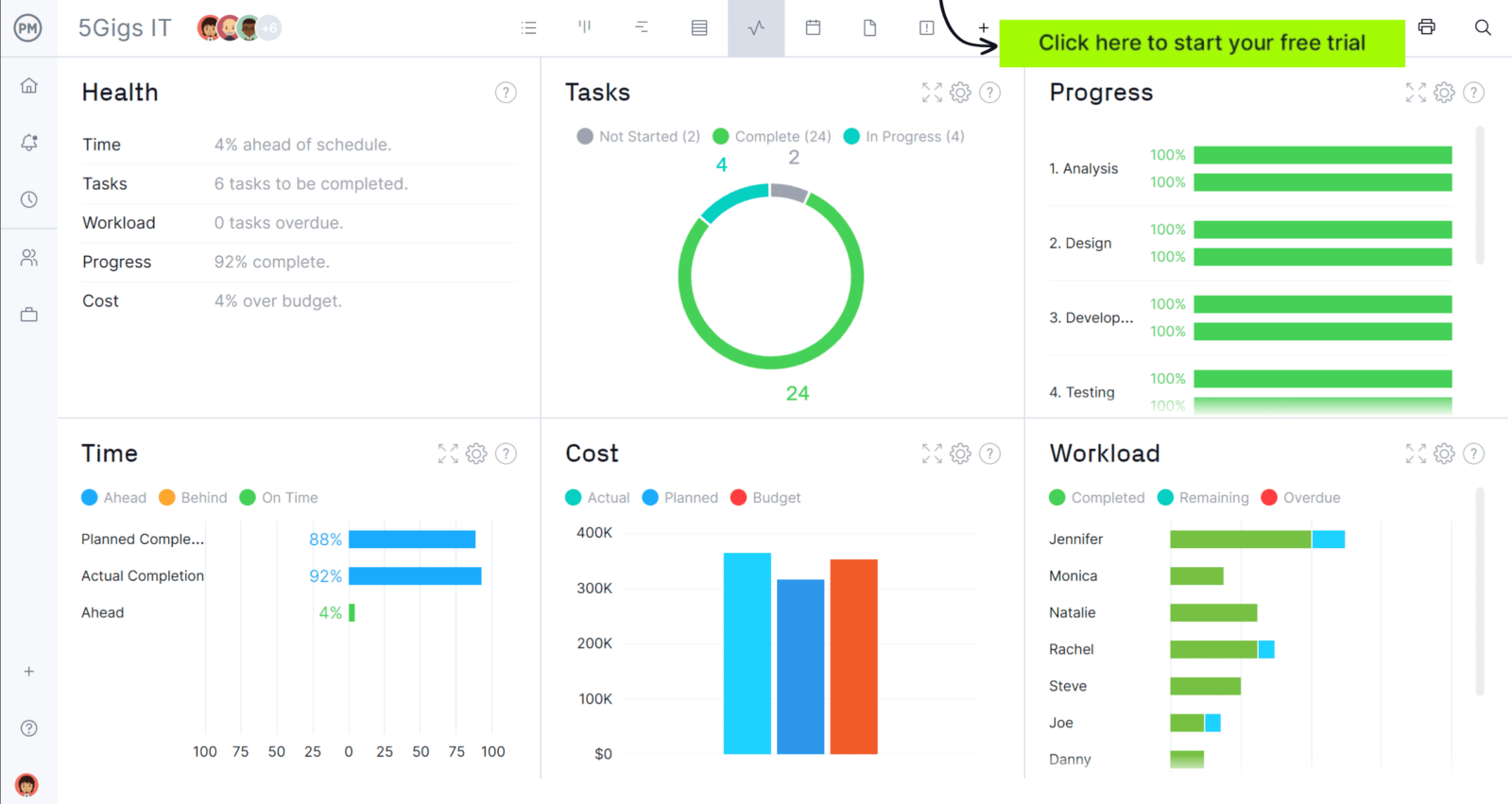
We also look at the resource allocation throughout the project. We want to know, do we have resources that are over-utilized or under-utilized? If you have resources that are over-utilized, that’s going to increase your cost. If you have them under-utilized, you may need to look at, number one, are those resources that you can use to help the others who may be over utilized? If they’re under-utilized, you need to look closer to make sure, are they actually completing their work? They may need some more training or support to get their work done.
And the third one is labor cost. You want to keep a close eye on your labor cost to see, are you over budget? Are you under budget? And what are the things you need to do to get it back on track if there’s a cost overrun? But if you need a tool that can help you manage your KPIs, then sign up for our software now at ProjectManager.
Top 10 Project Management KPIs
Below are the top 10 KPIs for project management. Whether you’re new to project management or a veteran, these KPIs can help you stay on track.
1. Net Profit Margin
The net profit margin is a financial ratio that looks at a company’s profitability based on the net income or profit generated from each dollar of revenue. The higher the net profit margin, the more profitable a company is.
Net profit margin = (Net income / Total revenue) x 100
2. Schedule Variance
Schedule variance (SV) is a project management metric that measures the difference between a project’s planned and actual progress at any given point in time. Use SV to determine whether is ahead of schedule, behind schedule or on track.
Schedule variance (SV) = Earned value (EV) – Planned value (PV)
3. Cost Variance
Cost variance (CV) is another project management KPI that measures the difference between a project’s budgeted cost and its actual cost at any given time. This KPI helps determine if the project is under or over budget.
Cost variance (CV) = Earned value (EV) – Actual cost (AC)
4. Schedule Performance Index (SPI)
Schedule performance index (SPI) measures how efficient a project’s schedule is. It compares the actual progress to the planned progress.
SPI = Earned value (EV) / Planned value (PV)
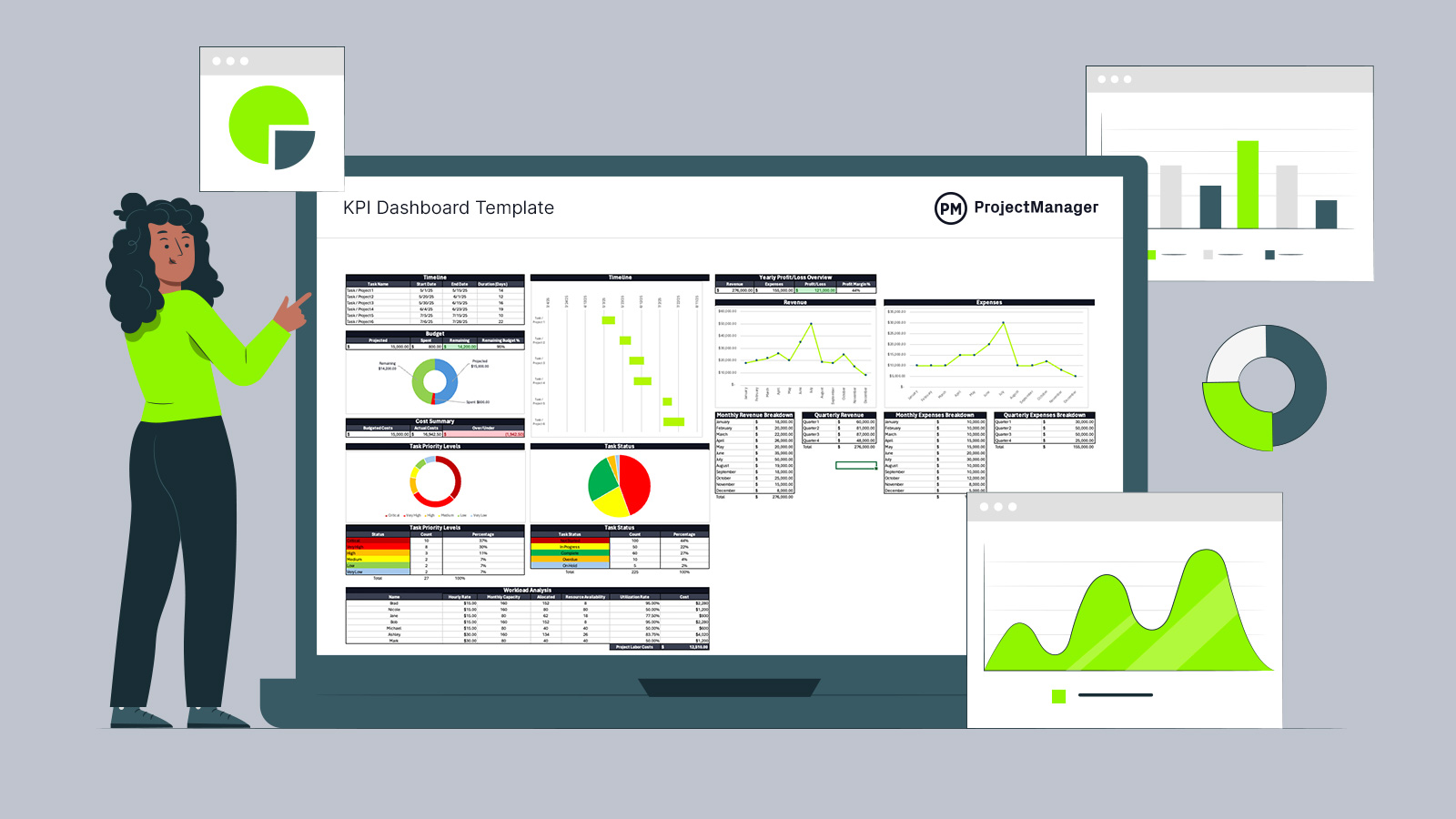
Get your free
KPI Dashboard Template
Use this free KPI Dashboard Template for Excel to manage your projects better.
5. Cost Performance Index (CPI)
Another important KPI in project management is cost performance index (CPI). This metric measures the cost efficiency of a project by comparing the budgeted cost of work performed to the actual cost of work performed.
Cost performance index (CPI) = Earned value (EV) / Actual cost
6. Return on Investment (ROI)
The return on investment (ROI) measures the profitability of an investment relative to its cost. This is one of the most important project KPIs to evaluate the efficiency and effectiveness of an investment.
7. Planned Value (PV)
Planned value (PV) describes the budgeted cost of work scheduled for a specific time period. It’s also known as the budgeted cost of work scheduled.
Planned value (PV) = Budgeted cost of work scheduled
8. Earned Value (EV)
Earned value (EV) is a project management technique that measures the actual value of the work completed to date. This key metric assesses project progress and performance.
9. Resource Utilization Rate
Resource utilization rate measures the efficiency of resource allocation in a project or organization. It shows the percentage of time a resource, such as a team member or piece of equipment, is actively working on billable or productive tasks.
Resource utilization rate = (Actual hours worked / Total available hours)
10. Project Burn Rate
The project burn rate is a financial project KPI that looks at how quickly a project is consuming its budget over a specific period.
Project burn rate = Total project budget / Project duration
Why Is It Important to Use Project Management KPIs to Track Project Performance?
The KPIs are very important measures that help us determine, at a quick glance, where we are. It helps us instantly discern the status, and it’s merely a rough guide. So we constantly look at these measures to help us as a guidepost to know how we need to navigate on our project.
For project management KPIs to work as intended, some of the best practices in selecting the KPIs for your project are that you develop these KPIs jointly with the people who are involved. You also get the stakeholders to agree on these KPIs. You also need to make sure that they’re relevant to the project. If you’re measuring things that aren’t relative to the project, then you’re going to be spending time with no results. Also, again, you want them specific and measurable.
How to Use ProjectManager to Track Project KPIs
KPIs in project management are incredibly important, but you need a strong tool that can make tracking them that much easier. That’s exactly what you can expect with ProjectManager, award-winning project management software. We have multiple tools that collect data in real time so you can work confidently knowing that you’re using the most updated project and portfolio data.
Real-Time Project Management Dashboards
ProjectManager’s real-time project management dashboards automatically collect and track six key project metrics including data on overall project health, tasks, progress, time, cost and workload. Utilize the color-coded graphs to quickly know if your project is progressing as it should or if there are bottlenecks that require your attention.
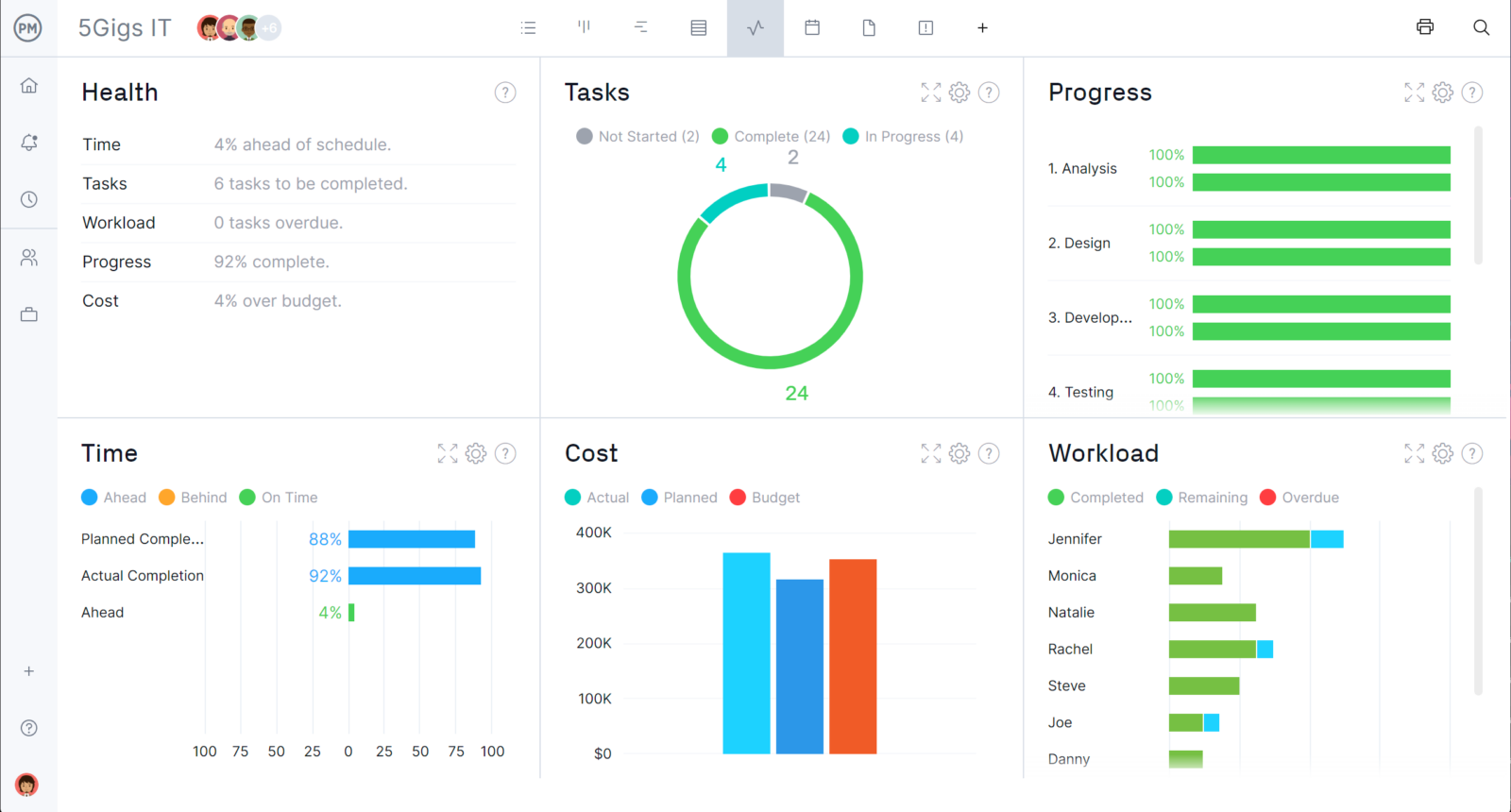
Multiple Project Planning and Scheduling Views
Productivity can occur regardless of how your team prefers to work. ProjectManager offers multiple project views including the Gantt chart, kanban board, task list, sheet view and calendar. The most powerful planning tool is the Gantt chart view where the project manager can add pertinent information such as planned versus actual data, assignee, priority level and more. If another team member prefers to work using the kanban board, all of the data transfers over in real time.
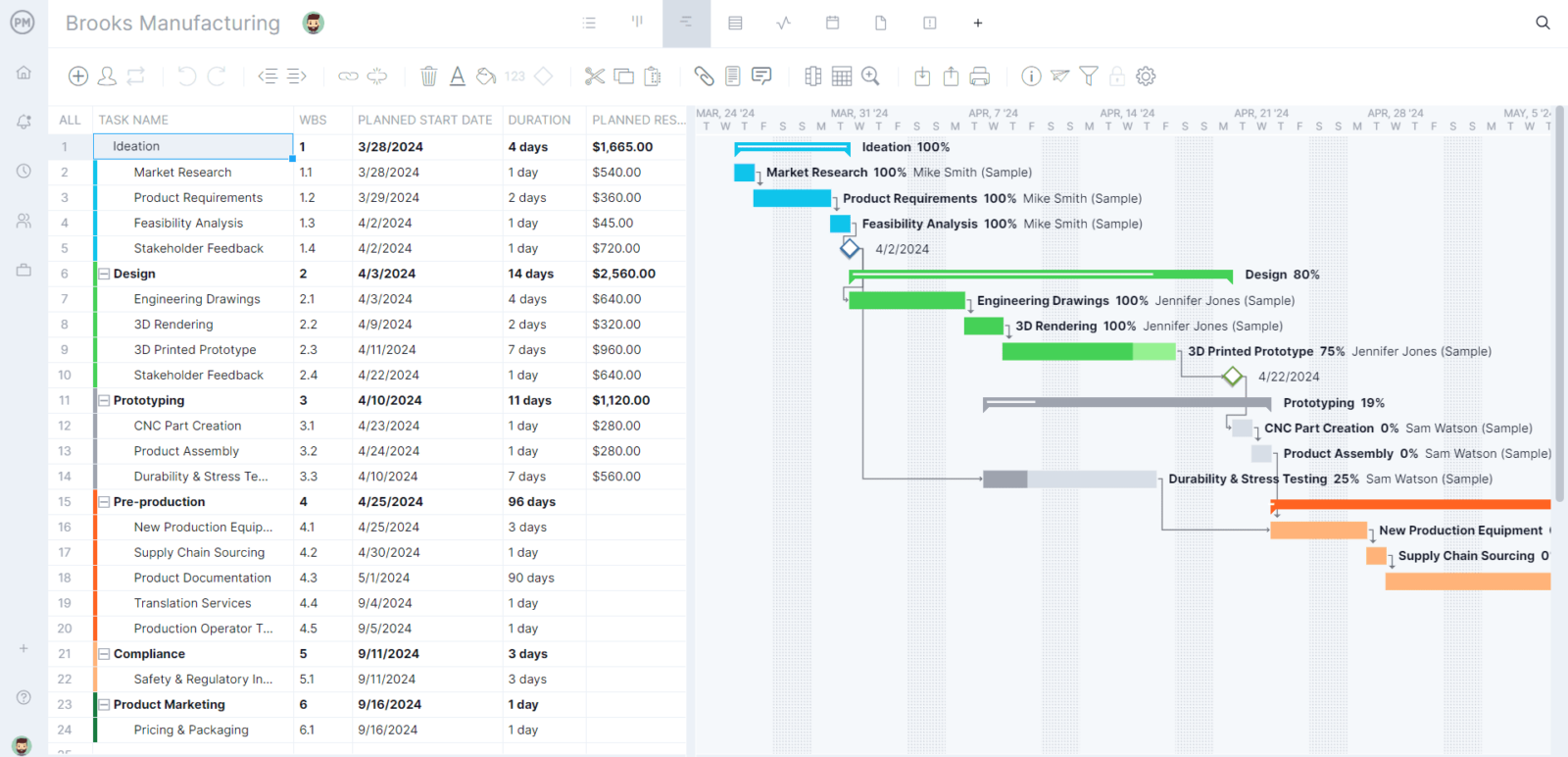
Robust Resource Management Features
When you’re onboarding your team, make sure to set their availability to make it easier to know when to assign them tasks. The team page makes it easy to identify PTO, vacation time and global holidays. To see who is overallocated or who could use additional tasks, use the color-coded workload chart that provides easily digestible data at a glance. Other resource management features such as timesheets automatically populate as data is entered into the project. ProjectManager makes it easy to keep everyone working at capacity so you can hit your target KPIs.
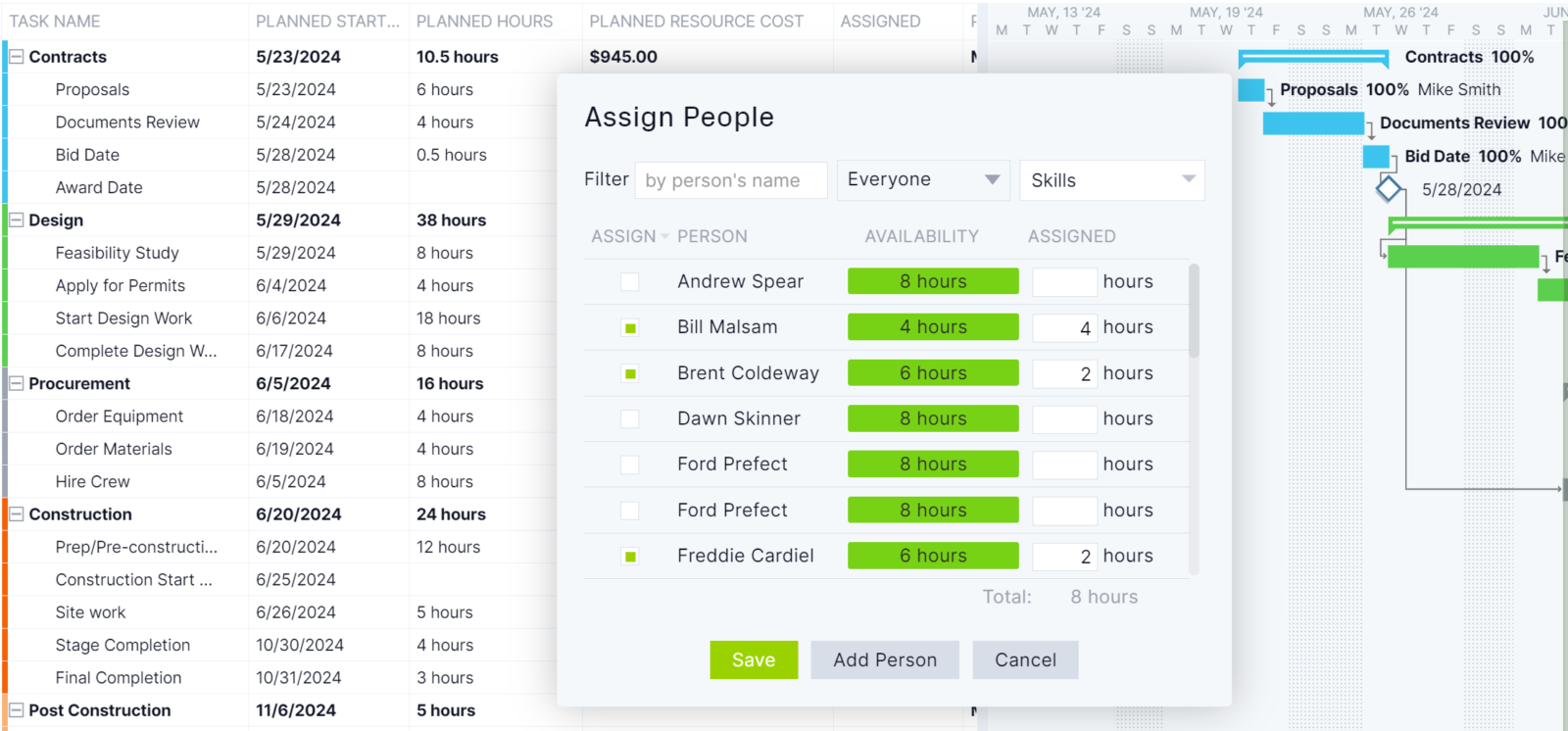
Video: Project Management KPIs Explained
Jennifer begins by explaining that KPI stands for Key Performance Indicator, in almost any industry. We have personal KPIs that we might have to reach as part of our performance review process at work. And then there are KPIs that are used to measure performance across teams or projects or entire sectors and industries.
For project managers, KPIs can be those specific measures for determining success on a project. Jennifer explained that you can use your KPIs as a guide to help you through your project. Those are the guideposts that can help you measure the time, cost, scope, and quality of the project. So what should you be tracking?
The top three things you’ll want to keep track are as follows:
- Schedule
- Resource allocation
- Labor costs
Pro-Tip: Establish specific and measurable KPIs in concert with the key stakeholders on your project and your team. Getting buy in from all parties is essential.
Take it further: If you’re interested in a more in-depth look at project KPIs, read how to establish a framework of KPIs in this article by PMI authors Gareth Byatt, Gary Hamilton and Jeff Hodgkinson
Thanks for watching!
Related Project Management Content
We’ve created hundreds of blogs, templates, ebooks and videos on project management topics to help you manage projects successfully. Here are some that are related to project management KPIs.
- Top Project Metrics You Need to Track
- Using Earned Value Management to Measure Project Performance
- Project Monitoring and Control: Tools & Steps
ProjectManager is online project management software that connects teams whether they’re working in the office, at the job site or anywhere in between. They can share files, comment at the task level and more. Join teams at companies such as Avis, Nestle and Siemens who use our software to deliver successful projects. Get started with ProjectManager today for free.

